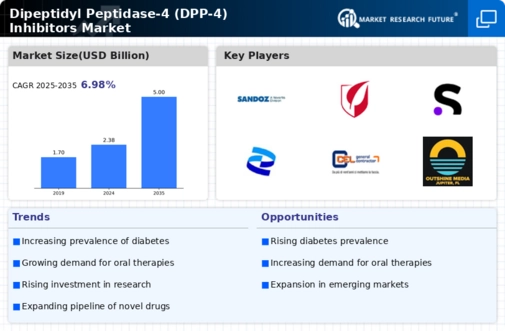Growing Prevalence of Diabetes
The rising incidence of diabetes, particularly type 2 diabetes, is a primary driver for the Dipeptidyl Peptidase-4 (DPP-4) Inhibitors Market. According to recent statistics, the number of individuals diagnosed with diabetes has surged, with estimates suggesting that over 500 million people are currently living with the condition. This increasing prevalence necessitates effective management strategies, leading to a heightened demand for DPP-4 inhibitors, which are known for their efficacy in glycemic control. As healthcare systems strive to address this growing burden, the DPP-4 inhibitors are positioned as a vital component of diabetes management, potentially enhancing patient outcomes and reducing long-term complications associated with the disease.
Rising Awareness and Education
There is a notable increase in awareness regarding diabetes management and treatment options, which significantly influences the Dipeptidyl Peptidase-4 (DPP-4) Inhibitors Market. Educational initiatives by healthcare providers and organizations have led to better understanding among patients about the importance of medication adherence and lifestyle modifications. This heightened awareness is likely to drive the adoption of DPP-4 inhibitors, as patients become more informed about their treatment options. Furthermore, as healthcare professionals emphasize the benefits of these inhibitors, including their favorable side effect profile, the market is expected to witness a steady growth trajectory, reflecting the changing dynamics of diabetes care.
Increasing Geriatric Population
The demographic shift towards an aging population is a significant driver for the Dipeptidyl Peptidase-4 (DPP-4) Inhibitors Market. Older adults are at a higher risk of developing type 2 diabetes, and as the global population ages, the demand for effective diabetes management solutions is likely to rise. This demographic trend is prompting healthcare systems to seek out effective treatments that can be easily integrated into the care plans of elderly patients. DPP-4 inhibitors, with their favorable safety profile and ease of use, are becoming increasingly popular among healthcare providers. Consequently, the market is expected to expand as more elderly patients are diagnosed and treated with these inhibitors.
Regulatory Support and Approvals
The Dipeptidyl Peptidase-4 (DPP-4) Inhibitors Market is benefiting from favorable regulatory environments that support the approval and commercialization of new therapies. Regulatory agencies are increasingly recognizing the importance of DPP-4 inhibitors in diabetes management, leading to expedited review processes for new formulations and combinations. This regulatory support not only accelerates the availability of innovative treatment options but also instills confidence among healthcare providers and patients. As new DPP-4 inhibitors enter the market, the competitive landscape is expected to intensify, potentially driving down costs and improving accessibility for patients, thereby expanding the overall market.
Technological Advancements in Drug Development
Innovations in drug development technologies are propelling the Dipeptidyl Peptidase-4 (DPP-4) Inhibitors Market forward. Recent advancements in formulation techniques and drug delivery systems have enhanced the efficacy and safety profiles of DPP-4 inhibitors. For instance, the development of once-daily formulations has improved patient compliance, which is crucial for chronic conditions like diabetes. Additionally, the integration of digital health technologies, such as mobile health applications, is facilitating better monitoring and management of diabetes, further driving the demand for DPP-4 inhibitors. As these technological advancements continue to evolve, they are likely to create new opportunities within the market, potentially leading to increased sales and market penetration.



















Leave a Comment